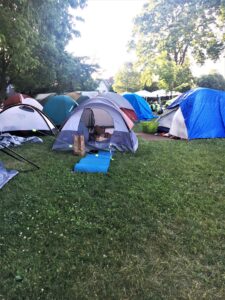BY KAY SCHROVEN
Since early June, we have new neighbors in Powderhorn Park. The media called it “the tent encampment,” described then as over
100 (and growing) homeless people living in tents, some evicted from the local Sheraton Hotel where they were being temporarily housed, post protests/riots and the associated destruction. The current population is at least 300, I’ve heard.
Living a half block off the park, I’ve met a few of my new neighbors. Closest to my house is a family of three in two tents: Johnny, his mother, Mae, and his wife, Julia (not their real names). They are white. They have been looking for a new home, having started out in Denver. Mae has ties in Minneapolis so they thought they’d try a new start here. They did not come until after the protests/riots. Johnny has no use for the government or police. He prides himself on self-sufficiency and has rigged up a makeshift shower under a tree. He believes in defending oneself. They had not been staying at the Sheraton. They like Minneapolis—“It’s friendly and people seem to care”—thanks to the Minneapolis Sanctuary Movement and other socially-minded organizations. Johnny has done time for drug dealing but really just wants an opportunity to work and support his mom and wife and live in an apartment “like normal people.” He has skills working with cement. He and his wife took a bus to Brooklyn Center to apply for warehouse jobs at Amazon.
While talking to them, a young Native American woman approaches with a shopping cart full of stuff, including a tent. I learn
that the city is providing tents. Wanda seems confused and declares that she’s never set up or even slept in a tent. She wanted to stay on the northwest side of the park because “over there (east side) I have some enemies and I don’t want to be around

(Photo/Nathan House)
needles.” Johnny and Julia helped Wanda erect her tent in a shady spot. By now Johnny and Julia know the shady from the sunny.
I walked farther into the park. I see that there are now five port-a-potties. Yesterday there were only two. As I walked farther south, I saw that another area of the park, the east side, is growing in tents. I’m told that that is the area for families with children because it is near the playground.
When I wander the park, I bring supplies: water, bread I baked, canteens of coffee, TP, etc. People seem very appreciative.
As I leave, Johnny invites me to come back this evening: “Mom will be up by then.” I guess he figures I am closer to his mom’s age than his and that we might have things in common.
Wednesday night, June 24, the Powderhorn Community Outreach meeting in the park drew a good-sized crowd; about 100 people. Janet Collins from the Minneapolis Conflict Resolution Center did a nice job of equalizing the meeting, laying down ground rules and allowing anyone to speak, encouraging listening and withholding of judgment. There were neighborhood residents and “tenters” in attendance. There was a mixture of feelings expressed (ranging from compassion to anger), concerns, perspectives and ideas. Neighborhood residents expressed concerns about safety, garbage, foul language and drug usage in the park. Tenters of course want solutions, mainly jobs and affordable housing; until this can be achieved, peace with their resident neighbors. Perhaps greater understanding was gained, but no concrete solutions.
The east side encampment of Powderhorn Park is growing: a sea of tents on the hill, with an impressive teepee in the center. People are sitting on lawn chairs, lying on mattresses, playing music, smoking cigarettes, visiting, holding babies, attending to tents, bicycles, water supplies, etc, There is a charging station for those lucky enough to have cell phones, a mental health tent, a donation center with a blackboard listing items “needed and accepted.” Amongst the needed are items such as shorts, Gatorade, water, ice, cigarettes and towels. Amongst the accepted: pillows, tarps, brooms. One tent was selling clothing and various items such as blankets, chips and soda pop, flashlights and batteries. The tent that captured my attention most was the “Kids Tent.” It is a square tent with a low ceiling and vented sides so that you can see into it. There are little child-size chairs, a table with pretty flowers in a vase and a big box of toys. The sign out front gave the hours of operation and encouraged people to call if they needed child care outside of these hours.
The guards, who wear bright neon vests, are volunteers. They work very long hours. Ron (not his real name) is an unemployed former military man. He lost his civilian job due to the recent riots. I ask Ron what the challenges are in the park. He says “I will not sugarcoat it, ma’am.” He continues, “Some of these people are bad news—thieves, drug users, very inconsiderate; you have to keep your cell phone concealed or it will disappear.” I learn that there are 14 families in this particular encampment, with more than 20 children. Ron says they take care of the families first, making sure they have food, water, diapers, sleeping arrangements, protection as they sleep. Ron adds, “Some of these folks had jobs a month ago, before everything burned down.”
I ask the guards if they’ve heard of any plans for longer term housing. They’ve heard rumors, but nothing concrete. They point out that as far as they know, no one from the city, county or state has visited the encampment. “They don’t care. It’s all about money.”






















